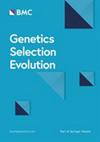使用五类功能变异与通用 SNP 比较奶牛泌乳性状的基因组预测准确性
IF 3.1
1区 农林科学
Q1 AGRICULTURE, DAIRY & ANIMAL SCIENCE
引用次数: 0
摘要
基因组选择,通常使用来自SNP芯片的遗传标记,在现代奶牛育种中是常规的。本研究评估了功能序列变异对50 k SNP芯片标记对泌乳奶牛脂肪百分比、蛋白质百分比、产奶量、脂肪产量和蛋白质产量的基因组预测准确性的影响。功能变异通过GWAS、RNA-seq、组蛋白修饰ChIP-seq、ATAC-seq或编码变异进行鉴定。利用每一类功能变异获得的基因组预测精度与从Illumina 50 k SNP芯片中随机选择的匹配数量的SNP进行比较。调查显示,通过GWAS或RNA-seq鉴定的变异显著提高了所有五个性状的预测准确性。ChIP-seq、ATAC-seq和编码变体的贡献有所不同。使用ChIP-seq识别的一些变异显示出明显的改善,而其他变异则降低了蛋白质产量预测的准确性。相对于来自SNP芯片的32,595个SNP的匹配数量,汇集所有功能变异表明,脂肪百分比的预测准确率提高了1.76%,蛋白质百分比提高了2.97%,奶量提高了0.51%,脂肪产量提高了0.26%,但蛋白质产量略有下降0.43%。该研究表明,相对于来自通用SNP面板的相同数量的变异,功能变异可以提高预测准确性,百分比性状比产量性状表现出更显著的收益。使用功能变异进行基因组预测的主要优点是使用更小、更具选择性的基因座集实现相当的准确性。这在特定于性格的场景中尤为明显。我们的研究结果表明,包含16k变体的功能变体的特定组合可以达到与使用两倍大小的标准面板(32.6 k)相当的基因组预测精度,特别是对于百分比性状。这凸显了利用功能变异开发更高效、以性状为重点的SNP面板的潜力。本文章由计算机程序翻译,如有差异,请以英文原文为准。
Comparison of genomic prediction accuracies in dairy cattle lactation traits using five classes of functional variants versus generic SNP
Genomic selection, typically employing genetic markers from SNP chips, is routine in modern dairy cattle breeding. This study assessed the impact of functional sequence variants on genomic prediction accuracy relative to 50 k SNP chip markers for fat percent, protein percent, milk volume, fat yield, and protein yield in lactating dairy cattle. The functional variants were identified through GWAS, RNA-seq, Histone modification ChIP-seq, ATAC-seq, or were coding variants. The genomic prediction accuracy obtained using each class of functional variants was compared with matched numbers of SNPs randomly selected from the Illumina 50 k SNP chip. The investigation revealed that variants identified by GWAS or RNA-seq, significantly improved the prediction accuracy across all five traits. Contributions from ChIP-seq, ATAC-seq, and coding variants varied. Some variants identified using ChIP-seq showed marked improvements, while others reduced accuracy in protein yield predictions. Relative to a matched number of 32,595 SNPs from the SNP chip, pooling all the functional variants demonstrated prediction accuracy increases of 1.76% for fat percent, 2.97% for protein percent, 0.51% for milk volume, and 0.26% for fat yield, but with a slight decrease of 0.43% in protein yield. The study demonstrates that functional variants can improve prediction accuracy relative to equivalent numbers of variants from a generic SNP panel, with percent traits showing more significant gains than yield traits. The main advantage of using functional variants for genomic prediction was achievement of comparable accuracy using a smaller, more selective set of loci. This is particularly evident in trait-specific scenarios. Our findings indicate that specific combinations of functional variants comprising 16 k variants can achieve genomic prediction accuracy comparable to employing a standard panel of twice the size (32.6 k), especially for percent traits. This highlights the potential for the development of more efficient, trait-focused SNP panels utilizing functional variants.
求助全文
通过发布文献求助,成功后即可免费获取论文全文。
去求助
来源期刊

Genetics Selection Evolution
生物-奶制品与动物科学
CiteScore
6.50
自引率
9.80%
发文量
74
审稿时长
1 months
期刊介绍:
Genetics Selection Evolution invites basic, applied and methodological content that will aid the current understanding and the utilization of genetic variability in domestic animal species. Although the focus is on domestic animal species, research on other species is invited if it contributes to the understanding of the use of genetic variability in domestic animals. Genetics Selection Evolution publishes results from all levels of study, from the gene to the quantitative trait, from the individual to the population, the breed or the species. Contributions concerning both the biological approach, from molecular genetics to quantitative genetics, as well as the mathematical approach, from population genetics to statistics, are welcome. Specific areas of interest include but are not limited to: gene and QTL identification, mapping and characterization, analysis of new phenotypes, high-throughput SNP data analysis, functional genomics, cytogenetics, genetic diversity of populations and breeds, genetic evaluation, applied and experimental selection, genomic selection, selection efficiency, and statistical methodology for the genetic analysis of phenotypes with quantitative and mixed inheritance.
 求助内容:
求助内容: 应助结果提醒方式:
应助结果提醒方式:


